– contributed by Tony Pankuch.
Browsing the contents of the Ludy T. Benjamin, Jr. Popular Psychology Magazine Collection, one is likely to come across some eyebrow raising titles and headlines from throughout the 20th century. The contents of the collection range from field standard publications like Psychology Today to the long-running Fate magazine, which featured parapsychological phenomena and headlines like “The Severed Head Spoke“. Yet as a queer person interested in the history of psychology and the LGBTQ+ community, the collection provides a fascinating opportunity to explore how LGBTQ+ individuals understood and sought to express their identities in relation to dominant psychological ideologies.
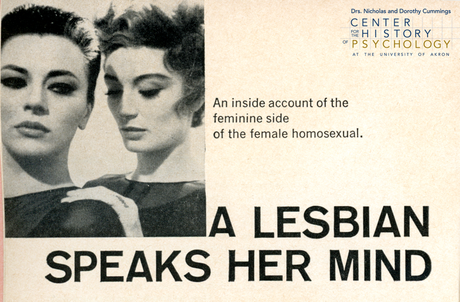 Sexology magazine, Vol. 33, No. 3, October 1966, from the Ludy T. Benjamin, Jr. Popular Psychology Magazine Collection
Sexology magazine, Vol. 33, No. 3, October 1966, from the Ludy T. Benjamin, Jr. Popular Psychology Magazine Collection If you’re familiar with the broad strokes of psychology’s historical relationship to the LGBTQ+ community, you likely know that prior to the 1970s there was little opportunity for the open expression of diverse sexual orientations and gender identities within the mental health fields. As explored by works like Henry L. Minton’s Departing From Deviance and the CCHP’s online exhibit A Clockwork Lavender, LGBTQ+ identities were viewed as disorders to be cured rather than legitimate expressions of human diversity.
Yet in popular sexology magazines, articles featuring the firsthand testimony and perspectives of LGBTQ+ individuals were not altogether uncommon prior to the 1970s. In an era when criminalization, medicalization, and inhumane treatment of LGBTQ+ identity was common in the U.S. and abroad, individuals were able to use the space in magazines to advocate (often anonymously) for their own humanity. An early example of this sort of article appeared in the September, 1934 issue of Sex: Sane Sex Standards:
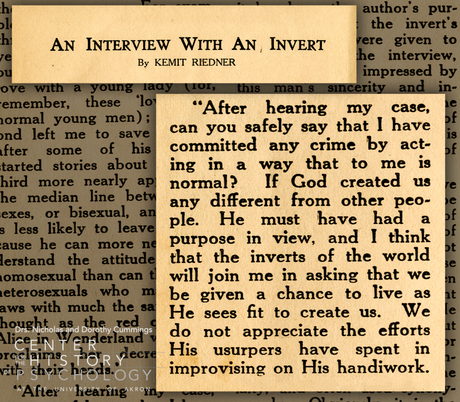 Sex: Sane Sex Standards, Vol. 4, No. 3, September 1934, from the Ludy T. Benjamin, Jr. Popular Psychology Magazine Collection
Sex: Sane Sex Standards, Vol. 4, No. 3, September 1934, from the Ludy T. Benjamin, Jr. Popular Psychology Magazine Collection After hearing my case, can you safely say that I have committed any crime by acting in a way that to me is normal? If God created us any different from other people. He must have had a purpose in my view, and I think that the inverts of the world will join me in asking that we be given a chance to live as He sees fit to create us. We do not appreciate the efforts His usurpers have spent in improvising on His handiwork.
In this article, author Kemit Riedner interviewed an “intelligent, educated man” who identified himself as an “invert” (a common sexological term for homosexuality at that time). In the excerpt above, the anonymous man challenges the idea that homosexuality is abnormal or worthy of criminal status. The last portion of this excerpt, in particular, seems targeted at those who sought to “cure” LGBTQ+ identities through conversation therapies.
By the 1960s, articles of this nature had begun to appear regularly in Sexology magazine, which was founded in 1933 and paired sensational headlines and occasionally scandalous imagery with educational articles on a wide variety of topics. Take for instance this 1967 article from the pseudonymous “Rod Chase”:
 Sexology magazine, Vol. 33, No. 11, June 1967, from the Ludy T. Benjamin, Jr. Popular Psychology Magazine Collection
Sexology magazine, Vol. 33, No. 11, June 1967, from the Ludy T. Benjamin, Jr. Popular Psychology Magazine Collection I see sad homosexuals in gay bars and the only thing comparable is sad heterosexuals in normal bars. I see many unhappy heterosexuals, many unhappy marriages. Look at the divorce rate! Look at the wretched destructive marriages! But from this I do not conclude that heterosexuality is an illness.
On the other hand, in spite of prejudice, there are many homosexuals who are free human beings and who have capacity for love. They are creative and not sorry for themselves. They are never considered when doctors write about homosexuality.
Sexology provided LGBTQ+ contributors and interview subjects an opportunity to speak out emphatically to an audience that was, by nature of the magazine’s existence, likely to be sympathetic or at least open to the diversity of human sexual experiences. In this way, it followed in the footsteps of early sexology researchers like Havelock Ellis and Richard von Krafft-Ebing. As explained by Henry L. Minton in Departing From Deviance, “for many homosexual research participants, the research process became a proactive vehicle for changing public opinion and constructing more empathic and realistic understandings of homosexuality.” Though this research may have still contributed to pathological understandings of queer identity, research participants were able to exercise agency through their participation and testimony.
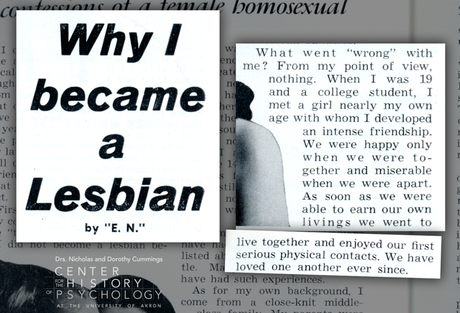 Sexology magazine, Vol. 31, No. 8, March 1965, from the Ludy T. Benjamin, Jr. Popular Psychology Magazine Collection
Sexology magazine, Vol. 31, No. 8, March 1965, from the Ludy T. Benjamin, Jr. Popular Psychology Magazine Collection What went ‘wrong’ with me? From my point of view, nothing. When I was 19 and a college student, I met a girl nearly my own age with whom I developed an intense friendship. We were happy only when we were together and miserable when we were apart. As soon as we were able to earn our own livings we went to live together and enjoyed our first serious physical contacts. We have loved one another ever since.
It wasn’t just gay and lesbian writers who wrote to Sexology. Transgender contributors were featured, as in the August 1960 issue:
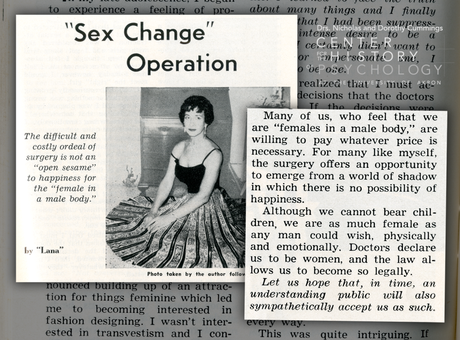 Sexology magazine, Vol. 27, No. 1, August 1960, from the Ludy T. Benjamin, Jr. Popular Psychology Magazine Collection
Sexology magazine, Vol. 27, No. 1, August 1960, from the Ludy T. Benjamin, Jr. Popular Psychology Magazine Collection Many of us, who feel that we are ‘females in a male body,’ are willing to pay whatever price is necessary. For many like myself, the surgery offers an opportunity to emerge from a world of shadow in which there is no possibility of happiness.
Although we cannot bear children, we are as much female as any man could wish, physically and emotionally. Doctors declare us to be women, and the law allows us to become so legally.
Let us hope that, in time, an understanding public will also sympathetically accept us as such.
Despite the ominous introduction—”surgery is not an ‘open sesame’ to happiness”—the article focused on physical recuperation and societal prejudice rather than any sort of psychological distress associated with trans identity, and Lana described herself as having “absolutely no regrets” for pursuing life as a transgender woman. This open and positive tone toward transgender identity makes sense for Sexology; for decades the magazine’s Board of Medical and Sexological Consultants included Dr. Harry Benjamin, a pioneer in gender-affirming surgery for transgender people, who wrote the introduction to Christine Jorgensen’s autobiography.
I’ll leave you with one more article, contributed by Lorynca Rome, from November, 1950:
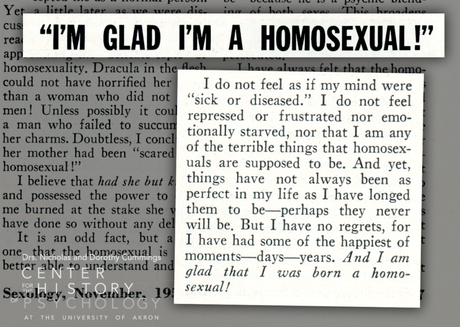 Sexology magazine, Vol. 17, No. 4, November 1950, from the Ludy T. Benjamin, Jr. Popular Psychology Magazine Collection
Sexology magazine, Vol. 17, No. 4, November 1950, from the Ludy T. Benjamin, Jr. Popular Psychology Magazine Collection I do not feel as if my mind were ‘sick or diseased.’ I do not feel repressed or frustrated nor emotionally starved, nor that I am any of the terrible things that homosexuals are supposed to be. And yet, things have not always been as perfect in my life as I have longed them to be—perhaps they never will be. But I have no regrets, for I have had some of the happiest of moments—days—years. And I am glad that I was born a homosexual!
Through these articles, LGBTQ+ contributors challenged the dominant narrative that queer life was abnormal and unfulfilling. They expressed themselves as individuals comfortable in their identities and without shame. They were, in a very literal sense, celebrating Pride.
Browse the finding aid to the Ludy T. Benjamin, Jr. Popular Psychology Magazine Collection.
Explore more materials on the history of LGBTQ+ psychology from the Cummings Center.
References
Jorgensen, C. (1967). Christine Jorgensen: personal autobiography. P. S. Eriksson.
Minton, H. L. (2010). Departing from deviance. University of Chicago Press.
